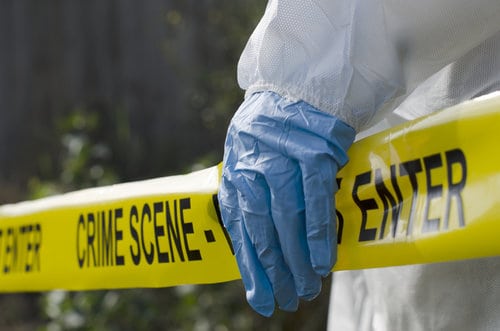
Many years ago when I was a resident, I learned that personal safety is a real concern for healthcare providers. In the ED where I was working, interviews with patients who had psychiatric problems were carried out in a dedicated room.
This room was equipped with a panic alarm which appears as part of the wainscoting decorative trim. If the provider felt threatened, s/he would just have to bump that alarm with an elbow. Fortunately, I had been given some good advice in how to keep myself safe so I never needed to use the alarm.
On one occasion, when I sensed the patient would become hostile when I didn’t give them what they were asking for, I excused myself from the room briefly to “check on something” and alerted the hospital security. Fortunately, it was a tertiary care hospital with some very impressive (large) security people. I returned to the room with the two security guards waiting unseen in the hallway. I informed the patient that we would not admit to psych and he needed to go to the local detox. As expected, he started to move towards me, clenching his fist preparing to strike as I was backing out of the room. As soon as he stepped in the hallway he saw the security team and immediately deflated his aggressive posture, mumbling expletives as he proceeded to leave the ED.
Your first responsibility at a scene is your own safety. You can’t help anyone if you get hurt. Sometimes the nature of the call will alert you to the need to protect yourself from violence or environmental hazards. For example, if responding to an assault or shooting, you will not proceed to the patient until the scene is deemed safe by police. MVA scenes likewise should be secured and traffic-controlled before you go to the patient.
Sometimes patients behave unexpectedly. This is especially true in the case of intoxicated, combative or demented patients. When approaching potentially volatile people, keep a calm demeanor, with a relaxed posture. If possible, keep your hands open and either in front of you or at your sides, not behind you. Introduce yourself, listen, try to be respectful and keep your communication straightforward. Don’t argue or express your opinions about their behavior or lack of cooperation. Don’t do anything without asking first. Make sure to position yourself between the patient and the door so you have an escape.
Sometimes, because of working in the same town as the county jail, I would see people from or on their way to jail. Most of these folks were harmless, but a few weren’t. I would get some sense of how dangerous they were by the number of police present in the room as I entered. If concerned, I would gather my history from the patient out of striking distance from them. When I moved closer to examine them, I would keep a close eye on their posture, trying to read their mood and intent. As I was doing the exam, I generally tried to position myself in a way which would be better if I had to suddenly deflect a blow or a bite.
Discretion is the better part of valor. Listen to that feeling you get when you sense a threat. Ask for help. Sometimes you can do more harm than good when struggling with a combative patient to do a particular procedure or intervention. Decide what has to be done right now that is life-saving, and what can be deferred until you have more help, or until the patient can be sedated.
This room was equipped with a panic alarm which appears as part of the wainscoting decorative trim. If the provider felt threatened, s/he would just have to bump that alarm with an elbow. Fortunately, I had been given some good advice in how to keep myself safe so I never needed to use the alarm.
On one occasion, when I sensed the patient would become hostile when I didn’t give them what they were asking for, I excused myself from the room briefly to “check on something” and alerted the hospital security. Fortunately, it was a tertiary care hospital with some very impressive (large) security people. I returned to the room with the two security guards waiting unseen in the hallway. I informed the patient that we would not admit to psych and he needed to go to the local detox. As expected, he started to move towards me, clenching his fist preparing to strike as I was backing out of the room. As soon as he stepped in the hallway he saw the security team and immediately deflated his aggressive posture, mumbling expletives as he proceeded to leave the ED.
Your first responsibility at a scene is your own safety. You can’t help anyone if you get hurt. Sometimes the nature of the call will alert you to the need to protect yourself from violence or environmental hazards. For example, if responding to an assault or shooting, you will not proceed to the patient until the scene is deemed safe by police. MVA scenes likewise should be secured and traffic-controlled before you go to the patient.
Sometimes patients behave unexpectedly. This is especially true in the case of intoxicated, combative or demented patients. When approaching potentially volatile people, keep a calm demeanor, with a relaxed posture. If possible, keep your hands open and either in front of you or at your sides, not behind you. Introduce yourself, listen, try to be respectful and keep your communication straightforward. Don’t argue or express your opinions about their behavior or lack of cooperation. Don’t do anything without asking first. Make sure to position yourself between the patient and the door so you have an escape.
Sometimes, because of working in the same town as the county jail, I would see people from or on their way to jail. Most of these folks were harmless, but a few weren’t. I would get some sense of how dangerous they were by the number of police present in the room as I entered. If concerned, I would gather my history from the patient out of striking distance from them. When I moved closer to examine them, I would keep a close eye on their posture, trying to read their mood and intent. As I was doing the exam, I generally tried to position myself in a way which would be better if I had to suddenly deflect a blow or a bite.
Discretion is the better part of valor. Listen to that feeling you get when you sense a threat. Ask for help. Sometimes you can do more harm than good when struggling with a combative patient to do a particular procedure or intervention. Decide what has to be done right now that is life-saving, and what can be deferred until you have more help, or until the patient can be sedated.


